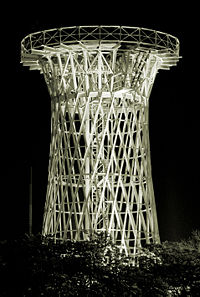Krasnodar
| Krasnodar (English) Краснодар (Russian) |
|
|---|---|
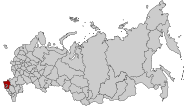 Location of Krasnodar Krai on the map of Russia |
|
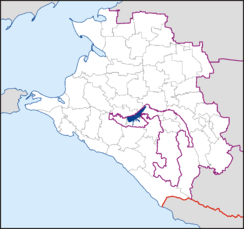 Location of Krasnodar on the map of Krasnodar Krai
|
|
| Coordinates |
|
| Coat of Arms | |
 |
|
| City Day: Last non-working day of September | |
| Administrative status | |
| Federal subject In jurisdiction of Administrative center of |
Krasnodar Krai Krasnodar Krai Krasnodar Krai |
| Local self-government (as of December 2007) | |
| Charter | Charter of Krasnodar |
| Municipal status | Urban okrug |
| Head | Vladimir Yevlanov |
| Legislative body | City Duma |
| Area | |
| Area | 841.36 km² (324.9 sq mi) |
| Population (as of the 2002 Census) | |
| Population - Rank - Density |
646,175 inhabitants 18th 768/km² (1,989.1/sq mi) |
| Events | |
| Founded | January 12, 1794 |
| Town status | 1867 |
| Renamed Krasnodar | 1920 |
| Other information | |
| Postal code | 350000..350090 |
| Dialing code | +7 861 |
| Official website | |
| http://www.krd.ru/ | |
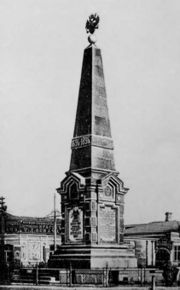
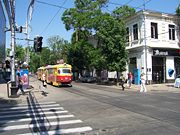
Krasnodar (Russian: Краснода́р) is a city in Southern Russia on the Kuban River. It is the administrative center of Krasnodar Krai (also known as Kuban).
Contents[hide] |
Name
It was founded on January 12, 1794 (Gregorian calendar) as Yekaterinodar (Екатеринода́р). The original name meant "Catherine's Gift" simultaneously in recognition of Catherine the Great's grant of land in the Kuban region to the Black Sea Cossacks (later the Kuban Cossacks) and in recognition of Saint Catherine, the Martyr, who is considered to be the patron of the city. After the October Revolution, Yekaterinodar was renamed Krasnodar (December, 1920). There are two potential meanings for the new name of the city: Krasno- (Красно-), meaning either 'beautiful' (an older root) or 'red' (especially relevant considering the political atmosphere of the time); and -dar (-дар), meaning 'gift'. Thus, the city's name means either beautiful gift or red gift (i.e. 'gift of the reds').
History

The origin of the city starts with a fortress built by Cossacks in order to defend imperial borders and claim Russian ownership over Circassia, which was contested by Ottoman Turkey. In the first half of the 19th century Yekaterinodar grew into a busy center of the Kuban Cossacks. By 1888 about 45,000 people lived in the city and it became a vital trade center of southern Russia. In 1897, an obelisk commemorating 200 year old history of Kuban Cossack Host was built in Yekaterinodar.
During the Russian Civil War the city changed hands several times between the Red Army and Volunteer Army, many Kuban Cossacks were committed anti-Bolsheviks who supported the White Movement. During the Great Patriotic War (World War II), Krasnodar was occupied by the German Army between August 12, 1942 and February 12, 1943. The city sustained heavy damage in the fighting but was rebuilt and renovated after the war.
Famous Russian soprano Anna Netrebko, cosmonaut Gennady Padalka, counterrevolutionary Andrei Shkuro and rhythmic gymnast Inna Zhukova were born in Krasnodar.
Coat of arms

The coat of arms of Yekaterinodar was introduced in 1841 by the Cossack yesaul Ivan Chernik. The royal letter "E" in the middle is for Ekaterina II (Russian for Catherine II). It also depicts the date city was founded, the Imperial double headed eagle (symbolizing Czar patronage of Black Sea Cossacks), a bulava of a Cossack ataman, Yekaterinodar fortress, and flags with letters "E", "P","A" and "N" standing for Catherine II, Paul I, Alexander I and Nicholas I. Yellow stars around the shield symbolized 59 Black Sea stanitsas around the city.
Architecture
The unique architectural steel lattice hyperboloid tower built by the Great Russian engineer and scientist Vladimir Grigorievich Shukhov in 1928—is located near Krasnodar Circus.
Travel information
The main airline is Kuban Airlines (at Krasnodar Pashkovsky Airport), and the largest hotels in the city include the Intourist, Hotel Moskva, Hotel Platan. Krasnodar uses a 220 V/50 Hz power supply with two round-pin like most European countries.
The major tourist attractions include St. Catherine's Cathedral, the State Arts Museum, a park and theatre named after Maxim Gorky, the beautiful concert hall of the Krasnodar Philharmonic Society, which is considered to have some of the best acoustics in southern Russia, State Cossack Choir and the Krasnodar circus.
Public transportation within Krasnodar consists of city buses, trolleybuses, trams, and marshrutkas. Trolleybuses and trams, both powered by overhead electric wires, are the main form of transportation in Krasnodar. Unlike Moscow and Saint Petersburg, Krasnodar does not have a metro system.
Sister cities
Krasnodar has four sister cities, as designated by Sister Cities International, Inc. (SCI):
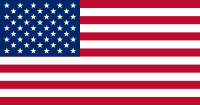 Tallahassee, Florida, United States
Tallahassee, Florida, United States Karlsruhe, Germany
Karlsruhe, Germany Burgas, Bulgaria
Burgas, Bulgaria Harbin, China
Harbin, China Ferrara, Italy
Ferrara, Italy
Famous people
- Anna Netrebko (b. 1971), opera singer
- Alexander Tamanian (1878–1936), Armenian neoclassical architect
- Gennady Padalka (b. 1958), cosmonaut
- Alexandre Bondar (b. 1972), writer and novelist
- Sergei Tiviakov (b. 1973), chess Grandmaster
- Eduard Kokcharov (b. 1975), handball player
- Natalia Chernova (b. 1976), gymnast
- Lazaros Papadopoulos (b. 1980), Greek basketball player
External links
- Official website of Krasnodar City Administration and City Duma
- Krasnodar photographs
- Inside Krasnodar blog
|
||||||||||||||
